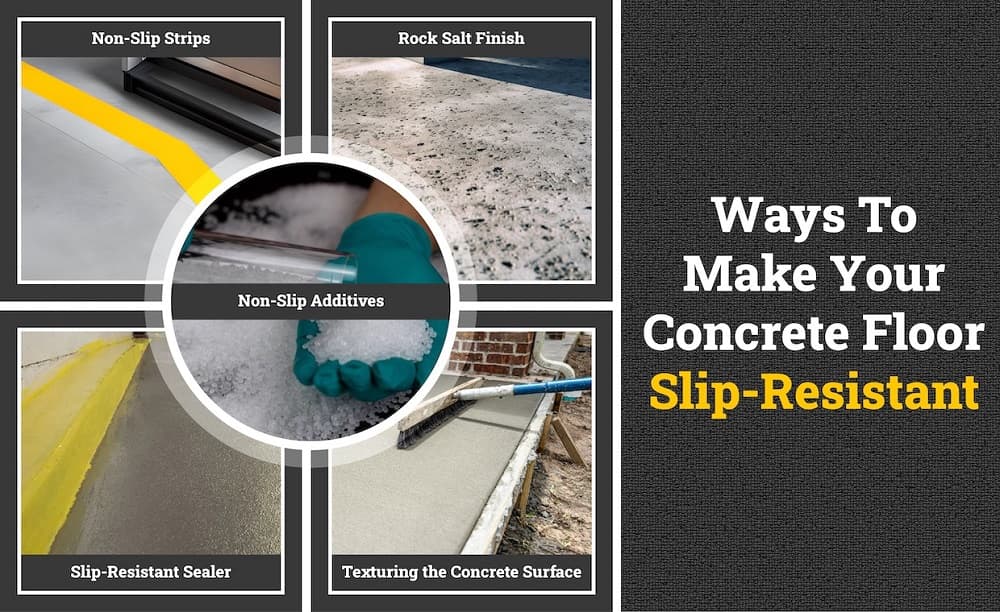
Well-constructed concrete surfaces can add to the beauty of their surroundings. Both inside and outside the home, concrete surfaces can improve the overall aesthetic. However, accidents involving slips and falls on concrete can happen more often than expected, especially when concrete surfaces are wet. Wet concrete floors can be particularly hazardous for the elderly, children, and young adults, who may suffer serious injuries due to tripping and falling on concrete. It’s important to take appropriate measures to avoid these risks.
One of the most widely used ways to measure a concrete floor’s slipperiness is through slip resistance, also known as the coefficient of friction. It measures concrete floor slip resistance in increments of tenths of a point, with 0 representing the most slippery surface. In this article, Gharpedia gives some tips to make your concrete floor slip resistant.
How to Make a Concrete Floor Slip-Resistant?
To make your concrete surface non-slippery, consider the following simple skid-safe measures.
01. Texturing the Concrete Surface

The brooming of newly laid concrete makes it slip-resistant. You can broom the concrete surface when it is partially dry. If the surface has a slope and a drain, broom the surface in the direction of the drain. You can use concrete brooms of various designs or a regular broom with stiff bristles for sweeping or brooming the concrete.
02. Slip-Resistant Sealer

A slip-resistant sealant must be the first item you test. You can try penetrative sealers, which do their magic underneath the surface rather than altering its structure. These sealants go deep into the pores, strengthening them from the inside out.
Because they don’t alter the surface, these sealers are naturally non-slip. Hence, with the sealer coating, you can walk on the concrete floor without fear of slipping.
03. Silica Sand
You can add silica sand to enhance the slip resistance of the concrete floor. The process involves applying a layer of silica sand to the initial coat of fresh, concrete slip-resistant sealer. Once it has dried, you can apply a second coat of concrete sealer and finish it. This approach may result in a slightly cloudy appearance on the surface.
04. Non-Slip Additives

To achieve the necessary concrete floor slip resistance, slip-resistant sealers may not be enough. In such cases, you can use non-slip additives. These additives come in two variations: fine or coarse, depending on the surface’s traction requirements.
05. Rock Salt Finish

You can give apply a rock salt finish to wet concrete surfaces before they fully cure. You need to sprinkle salt on the wet concrete surface and smooth it out with a trowel. Once the concrete fully cures, you need to wash away the salt. It reveals an aesthetically appealing texture with a non-slippery surface.
06. Muriatic or Hydrochloric Acid
If you apply muriatic acid to a concrete surface, it removes the top layer of concrete and exposes the sand aggregates within. It results in a concrete surface that has a slightly rough texture, like sandpaper. And you can make your concrete floor slip-resistant.
07. Paint and Primer

You can make the concrete surface less slippery by priming and repainting it with non-slip paint and primer with grit additives. Clear grit is an excellent choice as it works like silica sand since it does not cloud your concrete sealer while providing similar results. You can use sand and sawdust as grit additives. This newer material, made specifically for this purpose, is lighter and easier to mix with paint. Working with these additives will make the process much easier.
08. Non-Slip Strips

You can find these self-adhesive non-slip strips or anti-skid strips in local hardware stores and apply them to outdoor concrete surfaces such as driveways and patio steps. These strips stick to the concrete and give exceptional grip to prevent slippage.
Although this method is not aesthetically pleasing, it can help you meet floor slip resistance standards. Anti-skid strips are not suitable for treating indoor concrete surfaces.
09. Colour Hardener
Contractors can utilise colour hardeners as another effective method. Once you apply it, it provides heavy coverage and noticeable benefits. Unlike polymer grit, colour hardeners do not prominently appear on the surface. Additionally, it is more durable than sealer, which is crucial as the additive must prevent slipping when it wears out. Using this technique of colour hardener eliminates the issue of lifting off and ensures safety.
Conclusion
On a final note, while concrete surfaces can enhance your house’s overall look, it’s important to note that slips and other accidents can occur on them more often than they should. It’s always wise to take the necessary precautions to make your concrete floor slip resistant to ensure everyone’s safety. A non-slip concrete sealer or non-slip additives such as silica sand can be added during the concrete mixing and spread them before sealing the surface to make the concrete floor non-slippery. If the concrete is sealed, you can apply slip-resistant paint or non-slip strips.
Read More:
8 Types of Concrete Finishes You Need to Know
Author Bio
Sikandar Choudhury – Sikandar Monwar Huda Choudhury is a freelance article writer who is passionate about sharing his knowledge and experience with others through writing. With several years of experience in the engineering field and having written 100+ articles related to construction, Sikandar is a skilled writer with a talent for breaking down complex concepts and making them accessible to a wider audience. Sikandar is always looking for new opportunities to share his knowledge and experience with others through writing and is available for hire as a freelance civil engineering article writer. He is easily reachable on LinkedIn- https://www.linkedin.com/in/sikandar-monwar-huda-choudhury-2b3a1a20a/.






























